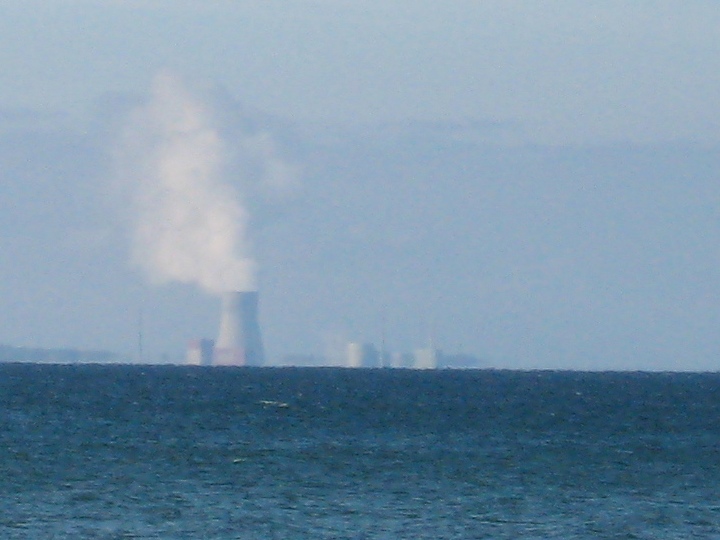FOR IMMEDIATE RELEASE
November 16, 2016
Contacts:
Paul Gunter, Beyond Nuclear, (301) 523-0201
Jessica Azulay, Alliance for a Green Economy, (315) 480-1515
Watchdogs seek hearing on Entergy request for delay of compliance with NRC Orders; Operators want to restart FitzPatrick reactor from January 2017 refueling without first completing the implementation of Fukushima Orders as required
Nuclear watchdogs are asking that the U.S. Nuclear Regulatory Commission (NRC) deny a September 8, 2016 request by Entergy Corporation to delay completion of safety systems upgrades at the FitzPatrick nuclear reactor in Scriba, NY. The upgrades were ordered following Japan’s 2011 Fukushima Daiichi nuclear catastrophe, and the deadline for completion is December 2016.
Beyond Nuclear and Alliance for a Green Economy are requesting that instead of granting Entergy’s extension request, the NRC convene a formal hearing to review serious safety issues raised by allowing FitzPatrick to continue operating without first achieving scheduled compliance with the Fukushima lessons learned requirements ordered by the federal agency.
The NRC Orders issued in 2012 and 2013 required reactor operators to begin “immediately effective” the design and installation of critical safety upgrades that were to be implemented by FitzPatrick before restart from the refueling outage in the fall of this year. Instead, in November 2015 Entergy announced that it would permanently close FitzPatrick in January 2017 and effectively cancelled scheduled work on the ordered upgrades. But thanks to the promise of large state subsidies and a possible sale of FitzPatrick to Exelon Corporation, Entergy now plans to refuel the reactor in January 2017 for an immediate restart without first completing the scheduled fixes and in fact with additional safety problems that have lingered for decades. On September 8, 2016, Entergy requested that the NRC grant it an “extension-to-comply” with the three Fukushima lessons learned Orders until June 30, 2017 for two of the Fukushima Orders and until June 30, 2018 for the third.
On November 10, 2016, Beyond Nuclear and Alliance for a Green Economy filed a petition requesting that the agency hold a hearing to require that Entergy adhere to NRC standard rules and procedures for making changes to an operating license that impact public safety. They are also calling on New York Governor Cuomo, whose administration is responsible for the subsidies that saved FitzPatrick from closure, to address the ongoing nuclear danger posed by the Fukushima-style reactor.
“FitzPatrick is a dangerous nuclear reactor, built with a flawed design,” said Jessica Azulay, program director of Alliance for a Green Economy. “We don’t believe there is a way to make that reactor totally safe, but it is beyond the pale that Entergy won’t even comply on time with these safety requirements that the NRC is imposed on them as long as four years ago.”
New York’s Public Service Commission recently approved approximately $7.6 billion in public subsidies for upstate nuclear reactors, including FitzPatrick, at the direction of the Governor. As a result of those subsidies, Exelon Corporation has agreed to buy the FitzPatrick nuclear reactor from Entergy and keep it going. The sale is expected to take several months. In the meantime, Entergy seeks to continue to operate FitzPatrick in violation of the licensing agreement and what NRC Orders determined to be “adequate safety.”
The safety upgrades that Entergy seeks to delay include the 2013 Order requiring the installation of a reliable severe accident capable hardened containment vent that would give operators the option to better control the release of extreme pressure, high temperature and explosive gases along with radiation in the event of an accident; the 2012 Order requiring more reliable measures to improve essential backup cooling to the reactor and the spent fuel pool in the case the site loses electrical power and; the 2012 Order requiring the installation of sensors and water level gauges for the plant’s densely packed radioactive fuel storage pool. The company has requested an extension of 18 months for the vent and 6 months for the backup cooling to the reactor and the spent fuel pool. All of those fixes should be completed and implemented by December 2016, according to the NRC deadline. All three Orders modified the technical specifications in the FitzPatrick operating license for scheduled compliance by the end of December 2016, which the petitioners argue Entergy can now only change through a license amendment process.
“Because Entergy is seeking a change to its license specifications for scheduled compliance with Orders, they must instead request a license amendment which triggers a hearing opportunity for any adversely affected parties according to NRC safety rules,” said Paul Gunter, director of reactor oversight at Beyond Nuclear in Takoma Park, MD. “The hearing would scrutinize Entergy’s plan to restart and operate FitzPatrick for at least another 18 months relying upon non-compliant containment ‘vulnerabilities’ that must be fixed before restart,” he said. Gunter is referring to the attached NRC May 2011 inspection report that specifically looked at FitzPatrick containment capabilities and identified “beyond design and design bases vulnerabilities” attributed to the operator’s refusal to implement a previous 1989 NRC request for MARK I containment venting improvements.
FitzPatrick is one of 22 operating MARK I Boiling Water Reactors in the United States that were built with a containment that is now demonstrated to be too small to actually contain the extreme pressure and temperature, explosive gases and radiation generated by a severe accident. The three Fukushima reactors that melted down, exploded, and released massive amounts of radiation into the air and water, were all GE boiling water reactors with the MARK I containment system. The lack of a reliable severe accident capable vent at the Fukushima reactors is one of the factors identified as causing the catastrophe, which is still ongoing, with large amounts of radiation still leaking uncontrollably from the plants.
LINKS TO DOCUMENTS
Beyond Nuclear and Alliance for a Green Economy November 11, 2016 petition requesting of a hearing and intervention before the NRC licensing board can be found here:
The NRC orders in question are as follows:
EA-12-049 (March 12, 2012) requires completion of scheduled enhanced mitigation strategies intended to maintain or restore cooling capabilities to the reactor core, the containment, and the spent fuel pool in the event of beyond-design-basis external events. The NRC order sets forth these functions as new requirements for back fits needed to provide adequate and necessary protection to public health and safety.
http://www.beyondnuclear.org/storage/mark-1-campaign/fof/fitzpatrick/fitz_ea-12-049_ML12056A045.pdf
EA-12-051 (March 12, 2012) requires completion and implementation of the reliable indication of the water level in spent fuel storage pools and the training of personnel to reliably monitor cooling water levels so as to ensure that: 1) water level is adequate to support operation of the normal fuel pool cooling system, 2) water level is adequate to provide substantial radiation shielding for a person standing on the spent fuel pool operating deck, and 3) the water level where fuel remains covered and actions to implement make-up water addition should no longer be deferred.
http://www.beyondnuclear.org/storage/mark-1-campaign/fof/fitzpatrick/fitz_EA-12-051-ML12054A679.pdf
EA-13-109 (June 6, 2013) includes two separate scheduled implementation phases for backfitting vulnerable GE Mark l boiling water reactor pressure suppression containment systems including Phase 1) modifications to venting systems for the “wetwell” component of the GE Mark l and Mark ll pressure-suppression containment system and Phase 2) modifications to the “drywell” component with severe accident capable hardened venting systems or implementation of an alternate non-prescriptive, performance-based containment strategy developed and advocated by the Nuclear Energy Institute.
http://www.beyondnuclear.org/storage/mark-1-campaign/fof/fitzpatrick/nrc_ea-13-109_ML13143A321.pdf
Entergy filed two requests with the NRC on September 8, 2016:
“Request for Extension to Comply with NRC Orders dated March 12, 2012 Modifying Licenses with Regard to Requirements Mitigation Strategies for Beyond-Design-Basis-External Events and Reliable Spent Fuel Pool Instrumentation (EA-12-049 and ES-12-051),”
and
“Request for Extension to Comply with NRC Order E-13-109, Order Modifying Licenses with Regard to Reliable Hardened Containment Vents Capable of Operation Under Severe Accident Conditions.”
http://www.beyondnuclear.org/storage/mark-1-campaign/fof/fitzpatrick/JAF_ext_ea-13-109_ORDER.pdf
NRC May 13, 2011 Inspection Report on FitzPatrick Containment Capability reports findings of beyond design and design bases vulnerabilities, See Enclosure pp. 8-9
About Beyond Nuclear
Beyond Nuclear aims to educate and activate the public about the connections between nuclear power and nuclear weapons and the need to abandon both to safeguard our future. Beyond Nuclear advocates for an energy future that is sustainable, benign and democratic. The Beyond Nuclear team works with diverse partners and allies to provide the public, government officials, and the media with the critical information necessary to move humanity toward a world beyond nuclear. Beyond Nuclear is headquartered in Takoma Park, MD.
About Alliance for a Green Economy
Alliance for a Green Economy (AGREE) works for safe, affordable energy and the development of a green economy in New York State. Our goal is a prosperous, safe, and healthy New York, fulfilling the promise of conservation, energy efficiency, and safe, clean renewable energy sources to end our state’s reliance on wasteful and environmentally destructive forms of energy. The Alliance works to promote this transition to a carbon-free and nuclear-free future and educates the public about alternatives that can revitalize the economy and safeguard human health and the environment. Alliance for a Green Economy is headquartered in Syracuse, NY.

